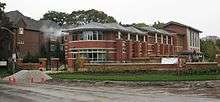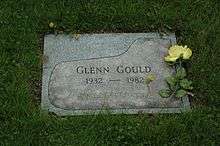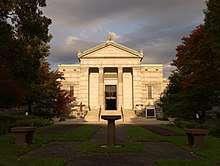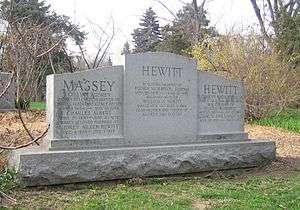Mount Pleasant Cemetery, Toronto
Mount Pleasant Cemetery is a cemetery located in Toronto, Ontario, Canada. The cemetery was opened in November 1876, and is located north of Moore Park, a neighbourhood of Toronto. The cemetery has kilometres of drives and walking paths, interspersed with fountains, statues, botanical gardens, and rare and distinct trees, originally laid out by German-born landscape architect Henry Adolph Engelhardt, inspired by the European and American garden cemeteries of the 19th century, and with influences from Mount Auburn Cemetery in Boston.[1]
.jpg) Mount Pleasant Cemetery's crematorium and mausoleum | |
| Details | |
|---|---|
| Established | November 4, 1876 |
| Location | |
| Coordinates | 43.696351°N 79.384882°W |
| Website | www.mountpleasantgroup.com |
| Official name | Mount Pleasant Cemetery National Historic Site of Canada |
| Designated | 2000 |
| Archives at | ||||
|---|---|---|---|---|
|
||||
| Using archival material | ||||
|
Help:Archival material Finding aids |
As the final resting place of more than 168,000 persons, Mount Pleasant Cemetery contains remarkable architecture amongst its many monuments. The cemetery was designated a National Historic Site of Canada in 2000.[2][3]
History
In the early 19th century, the only authorized cemeteries within the town of York (predecessor to present-day Toronto) were limited to the members of either the Roman Catholic Church or the Church of England. Deceased citizens who did not belong to either of these Christian denominations had no choice but to find burial arrangements outside of the city. Notably, those of Jewish faith who wanted a Jewish burial had to resort to cemeteries beyond Ontario (Montreal and Buffalo) until Pape Avenue Cemetery was opened outside of Toronto in 1849.
_(14775500251).jpg)
In response to a petition to the Legislative Council of Upper Canada, which included “...it has become desirable that a Plot be obtained for the purpose of a General Burying Ground, as well for Strangers as for the Inhabitants of the Town, of whatever sect or denomination they may be”, a statute named An act to authorize certain persons therein named, and their successors, to hold certain lands for the purpose therein mentioned was passed and received Royal Assent in 1826: Acts of U.C. 7 Geo. IV, c. 21.[4] The land that came to be known as the “Potters Field”[5] was acquired and started operation as a cemetery soon afterwards. Over time additional cemetery lands were added to what became the Toronto General Burying Ground.
In 1873, a new cemetery available to all citizens was established. The new cemetery was situated on an 81-hectare (200-acre) farm on Lot 19 Concession 3 (also referred to as Yonge Street Farm) once owned by the Cawthra family and likely by William Cawthra, on the far outskirts of the city. Mount Pleasant Cemetery formally opened on 4 November 1876 with more than 19 kilometres (12 mi) of carriage drives along rolling hills and ponds. Mount Pleasant Road was later constructed to pass through the centre of the cemetery and is named after this cemetery. The cemetery also has remains and a number of stone markers that were moved from the Potter's Field. The urban expansion of Toronto eventually led to Mount Pleasant being situated in the centre of the city.
A number of Canadian servicemen who died during the World Wars were interred at the cemetery. The cemetery contains 231 Commonwealth War Graves, comprising 126 burials in World War I and 105 in World War II. 188 are of the Canadian, and 43 the British, armed forces.[6]

In the autumn of 2009, the cemetery opened Mount Pleasant Visitation Centre. The new building is approximately 2,200 square metres (24,000 sq ft) and is built on the property grounds. It was built with the intention to provide visitation space and chapel services.[7]
The cemetery began planning the building as early as 2004, but disputes[8] with the City of Toronto government, local ratepayer associations, and the Ontario Municipal Board all delayed the project. Changes were made as a result of this process, most notably vehicle access is now through the cemetery grounds only (near the cemetery offices), not directly from Moore Avenue. [9] [10]
Memorials
- To commemorate the 118 lives lost in the fire that destroyed the Great Lakes luxury cruise liner SS Noronic on September 17, 1949, a memorial was erected by the Government of Ontario.
- To commemorate the 167 lives of members of the Salvation Army (1012 people in total died) lost in the sinking of the Empress of Ireland on May 29, 1914, a memorial surrounded by the graves of the deceased was erected by the Toronto unit of the Salvation Army.
- To commemorate the 109 lives lost in the crash of Air Canada Flight 621 on July 5, 1970, a memorial surrounded by graves of many of the dead was erected in May 1971.
- Children's Garden Memorial was created to remember all the stillborn and children without known parents the province buried in one area with no stones or markers.
- A memorial was erected sometime after 1912 in honour of two soldiers killed returning from a training exercise in 1912 and as a monument to the 48th Highlanders of Canada's veterans and war dead of the South African War.[11]
Notable interments
Business people
.jpg)
- John Paris Bickell (1884-1951), majority owner and chairman Toronto Maple Leafs, co-founder and chairman A.V.Roe Canada Limited Avro Canada.
- Alfred J. Billes (1902–1995), co-founder of Canadian Tire.
- George Montegu Black II (1911–1976), president of Canadian Breweries Limited.
- Matthew James Boylen (1907–1970), mining magnate (Brunswick Mining and Smelting Corp. Ltd), racehorse owner.
- William Mellis Christie (1829 – 1900) is the namesake for the Canadian Mr. Christie brand of cookies and biscuits.
- George Albertus Cox (1840–1914), businessman (founder of Central Canada Loan and Savings Company and National Trust Company), Ontario MP and Senator.
- Robert T. Davies (1849–1916), businessman, racehorse owner
- William Henry Davies (entrepreneur) (1831 – 1921) Canada's first meat packer, also first artificial refrigeration.
- Timothy Eaton (1834–1907), department store magnate (Eaton's)
- James Henry Gundy (1880–1951), stockbroker, co-founder of Wood Gundy Inc.
- Henry R. Jackman (1900-1979), businessman and politician, father of Lieutenant Governor Henry N.R. Jackman
- Albert Edward Kemp (1858–1929), businessman and politician
- Hart Massey (1823–1896), businessman (founder of Massey-Harris) and philanthropist
- William McMaster (1811–1887), banker, statesman, a founder of McMaster University and CIBC
- Ryland H. New (1888–1979), businessman (head of Hamilton and Toronto Sewer Pipe Company and founder of National Sewer Pipe Company Limited), racehorse owner
- Arthur Godfrey Peuchen (1859-1929), businessman (Standard Chemical, Iron & Lumber Company of Canada, Ltd), soldier; survivor of RMS Titanic
- Edward S. Rogers Sr. (1900–1939), founder of Rogers Majestic
- Joseph Rotman (1935-2015), businessman and philanthropist
- Steve Stavro (1926–2006), businessman (founder of Knob Hill Farms), horse breeder, former owner of the Toronto Maple Leafs
- Robert Simpson (1834–1897), department store magnate (Robert Simpson Limited)
- Kenneth Thomson, 2nd Baron Thomson of Fleet (1923 – 2006), businessman (son of founder of Thomson Corporation), art collector, richest person in Canada
- George Weston (1864–1924), businessman, founder of George Weston Limited
- W. Garfield Weston (1898–1978), businessman and British MP
Clergymen
- Arnold Brown (1913–2002), General of The Salvation Army
- Jonathan Goforth (1859–1936), Presbyterian Missionary
- Howard P. Whidden, clergyman, professor, politician (Manitoba MP), Chancellor of McMaster University
- Very Rev Dr Alexander Topp (1814-1879) twice Moderator of the Presbyterian Church of Canada
Medical personalities
- Sir Frederick Banting (1891–1941) & Charles Best (1899–1978), co-discoverers of insulin. Banting, a Major in the Royal Canadian Army Medical Corps at his death, is one of 231 Commonwealth war graves in the cemetery.[6]
- Bertha Harmer (1880–1934), prominent Canadian/American nurse
- Jennie Smillie Robertson (1878–1981), Canada's first female surgeon
Music personalities

- Mario Bernardi (1930-2013), pianist, conductor
- Bobby Gimby (1918–1998), writer of the Expo 67 theme: Ca-na-da
- Glenn Gould (1932–1982), musician, pianist, composer, musical theorist
- Alexander Muir (1830–1906), author of The Maple Leaf Forever (1867), Canada's early (unofficial) national anthem
- John Rutsey (1953-2008), original drummer for progressive rock band Rush
- Robert Watkin-Mills (1849-1930), concert and oratorio singer
Politicians
- James Cox Aikins (1823–1904), politician (Canada West MLA, Ontario Senator, federal cabinet minister), Lieutenant Governor of Manitoba
- John Black Aird (1923–1995), Lieutenant Governor of Ontario, lawyer
- Herbert Henry Ball (1863–1943), politician (Toronto alderman, Ontario MPP and cabinet minister (King's Printer of Ontario)
- Herbert Alexander Bruce (1868–1963), Lieutenant Governor of Ontario, surgeon
- William Clark (1836–1915), Lieutenant Governor of Ontario, lawyer
- Lionel Herbert Clarke (1859–1921), Lieutenant Governor of Ontario, brewer
- William Dennison (1905-1981), Mayor of Toronto, educator
- George Howard Ferguson (1870–1946), 9th Premier of Ontario
- Robert John Fleming (1854–1925), businessman, Mayor of Toronto
- Fred Gardiner (1895–1983), politician (reeve of Forest Hill, Metro Toronto Chairman)
- William Hearst (1864–1941), 7th Premier of Ontario
- George Stewart Henry (1871–1958), 10th Premier of Ontario
- Warring Kennedy (1827–1904), businessman, Mayor of Toronto
- Allan Lamport (1903–1999), Toronto Transit Commission Commissioner, Mayor of Toronto
- William Lyon Mackenzie King (1874–1950), Prime Minister of Canada[12]
- John Keiller MacKay (1888–1970), Lieutenant Governor of Ontario, lawyer, judge
- Albert Edward Matthews (1873–1949), Lieutenant Governor of Ontario, broker
- Samuel McBride (1866–1936), Mayor of Toronto, lumber merchant
- Oliver Mowat (1820–1903), 3rd Premier of Ontario
- John Rolph (politician) (1793–1870), was a physician, lawyer and political figure in Upper Canada.
- George William Ross (1841–1914), 5th Premier of Ontario
- Egerton Ryerson (1803–1882), minister, educator, politician (Chief Superintendent of Education for Upper Canada), and public education advocate
- Robert Hood Saunders (1903–1955), lawyer, Mayor of Toronto
- Sir Clifford Sifton (1861–1929), politician (Manitoba MLA, Ontario MP, federal Minister of the Interior)
- Donald Dean Summerville (1915–1963), Mayor of Toronto and Toronto Alderman (Beach)
- William Summerville (1879–1958), Member of Toronto Board of Control, Ontario MPP
- Thomas Urquhart (1858–1931), lawyer, Mayor of Toronto
Sports personalities
- Billy Burch (1900–1950), Hall of Fame ice-hockey player
- Charlie Conacher (1909–1967), Hall of Fame ice hockey player (NHL) and coach of the Oshawa Generals. Buried Section 41, Lot 351
- George Imlach (1918–1987), hockey player, NHL general manager and head coach
- Dick Irvin (1892–1957), Hall of Fame ice-hockey player and coach
- George Knudson (1937–1989), PGA Tour golfer
- Igor Korolev (1970–2011), Russian born NHL and KHL hockey player, KHL coach
- George Seymour Lyon (1858–1938), Olympic Gold Medal golfer
- Bill Zock (1918–1988), Hall of Fame CFL football player
Survivors of the Titanic
- Arthur Godfrey Peuchen Lieutenant-Colonel (1859–1929) was a Canadian businessman and RMS Titanic survivor. He was also a World War I veteran.
- Ethel Flora Fortune (1883-1961) was a first-class passenger and a survivor of RMS Titanic.
Veterans

- William George 'Billy' Barker, VC, DSO & Bar, MC & Two Bars (1894–1930), LCOL, 201 Squadron, RAF. World War I flying ace, Victoria Cross recipient.
- George Fraser Kerr, VC, MC & Bar, MM (1895–1929), CAPT, 3rd battalion (Toronto) Central Ontario Regiment, CEF. World War I Victoria Cross recipient.
- Guy Simonds senior officer of the Canadian Army in World War II, known as the "Liberator of Holland."
Other

- James Bain (1842–1908), first chief librarian of the Toronto Public Library
- Victor Child (1897–1960), painter, etcher and illustrator at the Toronto Telegram
- Greg Clark (journalist), OC OBE MC (25 September 1892 – 3 February 1977) was a Canadian war veteran, journalist, and humorist.
- Fred Davis (1921–1996), popular television and radio host
- Jack Dennett (1916–1975) was a Canadian radio and television announcer.
- Northrop Frye (1912–1991), educator, literary critic
- Edward Greenspan (1944–2014), famed defence lawyer
- Barbara Hamilton (1926-1996), actress
- Theodor August Heintzman (1817-1899) created Heintzman pianos
- Foster Hewitt (1902–1985), television and radio (hockey) broadcaster
- William Abraham Hewitt (1875–1966), sports journalist, manager at Maple Leaf Gardens
- Laura Muntz Lyall (1860–1930), impressionist painter
- David Milne (1882-1953), impressionist painter
- F. W. Micklethwaite (1849–1925), prominent photographer
- Alison Parrott (1974-1986), a murdered 11-year-old
- John A. Pearson, architect from the firm Pearson and Darling
- Boris Spremo (1935–2017), photojournalist
- Robert Sutherland (c.1830-1878), Canada's first black lawyer, and an important benefactor and alumnus of Queen's University
- W. Stewart Wallace (1884–1970), historian, librarian, and editor
- Peter Worthington (1927–2013), journalist
- Cecilia Zhang (1994-2003), murder victim
References
- Official web site
- Filey, Mike Mount Pleasant Cemetery (1990) Firefly Books ISBN 0-920668-69-0
- https://www.mountpleasantgroup.com/General-Information/Our%20Monthly%20Story/story-archives/mount-pleasant-cemetery/Mount%20Pleasant%20Cemetery.aspx
- Mount Pleasant Cemetery. Directory of Federal Heritage Designations. Parks Canada. Retrieved 10 February 2015.
- Mount Pleasant Cemetery. Canadian Register of Historic Places. Retrieved 10 February 2015.
- Early Canadiana Online
- Find A Grave
- CWGC Cemetery Report.
- http://www.visitationcentre.ca/MP_new-visit.html Accessed October 2nd, 2009
- http://canlii.ca/t/1qss1 Humphrey Funeral Home v. Toronto (City), 2007
- http://www.visitationcentre.ca/MP_design.html Accessed October 2nd, 2009
- http://www.moorepark.org/ Accessed October 2nd, 2009
- "48th Highlanders of Canada memorial". National Defence Canada. 2008-04-16. Archived from the original on 2014-05-23. Retrieved 22 May 2014.
- "A historical stroll through Canada's prime ministerial grave sites". theglobeandmail.com. Retrieved 27 July 2020.
External links
| Wikimedia Commons has media related to Mount Pleasant Cemetery. |
